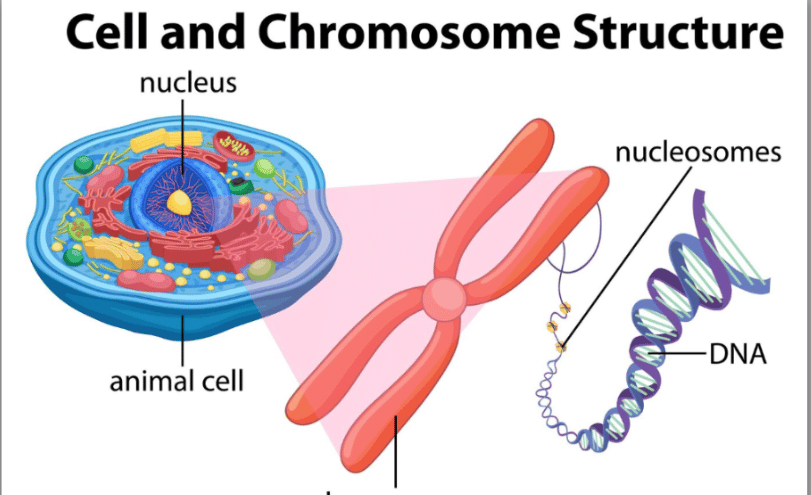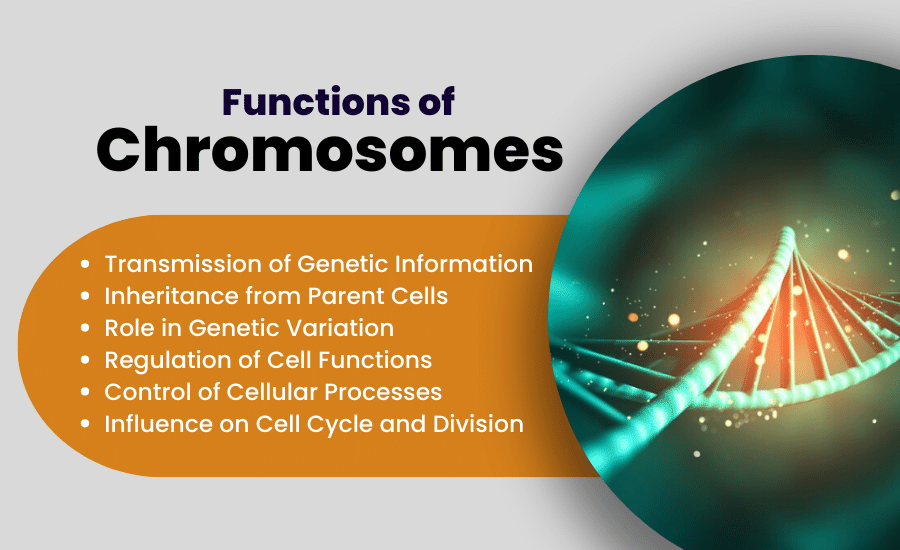What is Chromosomes
Chromosomes are thread-like structures composed of DNA and proteins found in the nucleus of a cell. They carry genetic information in the form of genes, which serve as instructions for the development, functioning, and maintenance of the organism. Each species has a specific number of chromosomes, and humans typically have 46 chromosomes in each cell, organized as 23 pairs.
The DNA in chromosomes contains the genetic code, and during cell division, chromosomes play a vital role in ensuring the accurate transmission of genetic information from parrent to daughter cells.

Importance of Chromosomes in Cell Biology
The importance of chromosomes in cell biology is multifaceted, playing crucial roles in various cellular processes and contributing to the overall functioning and integrity of living organisms. Here are some key aspects highlighting the significance of chromosomes:
- Genetic Information Storage:
Chromosomes serve as the primary carriers of genetic information in the form of genes. Genes are sequences of DNA that encode instructions for the synthesis of proteins and other molecules essential for cell structure and function.
- Inheritance and Genetic Variation:
Chromosomes are central to the inheritance of traits from one generation to the next. The combination of chromosomes from both parents during sexual reproduction contributes to genetic diversity in populations.
- Cell Division and Reproduction:
Chromosomes play a pivotal role in cell division processes, such as mitosis and meiosis. During mitosis, chromosomes ensure the accurate distribution of genetic material to daughter cells, maintaining genetic consistency. In meiosis, chromosome recombination promotes genetic diversity in gametes.
- Regulation of Cellular Processes:
Chromosomes are involved in the regulation of various cellular processes, including the cell cycle. Checkpoints in the cell cycle ensure that DNA replication and chromosome segregation occur accurately, preventing errors and maintaining cellular integrity.
- Structural Organization of DNA:
Chromosomes provide a structured organization for DNA. The DNA wraps around histone proteins to form nucleosomes, promoting compaction and preventing tangling. This organized structure facilitates efficient storage and retrieval of genetic information.
- Cell Differentiation and Specialization:
Chromosomes contribute to the process of cell differentiation, guiding cells to become specialized for specific functions within tissues and organs. This specialization is crucial for the proper functioning of multicellular organisms.
- Response to Environmental Factors:
Chromosomes can respond to environmental factors and stressors, influencing gene expression. This adaptability allows organisms to adjust to changing conditions, contributing to their survival and evolutionary success.
- Identification of Genetic Disorders:
Abnormalities in chromosome structure or number can lead to genetic disorders. Studying chromosomes helps in the identification of such abnormalities, enabling the diagnosis and understanding of various genetic conditions.
chromosomes are serving as the carriers of genetic information
Location of Chromosomes in a Cell
The location of chromosomes in a cell is primarily within the nucleus, the membrane-bound organelle that houses the genetic material. Here’s a detailed explanation:

1. Nucleus:
Primary Location: Chromosomes are predominantly located within the nucleus of eukaryotic cells. The nucleus serves as a compartment where genetic material is organized, replicated, and transcribed.
Structure: Inside the nucleus, chromosomes exist in a less condensed form during interphase, known as chromatin. As the cell prepares for cell division, chromatin undergoes further condensation to form distinct, visible structures called chromosomes.
2. Mitochondria:
Mitochondrial DNA (mtDNA): While the majority of an organism’s DNA is found in the nucleus, mitochondria also contain a small amount of genetic material in the form of mitochondrial DNA. This mitochondrial DNA is separate from nuclear chromosomes and is involved in cellular energy production.
Additional Information:
Cytoplasmic Components: During cell division, chromosomes play a critical role in ensuring the accurate segregation of genetic material into daughter cells. While chromosomes are primarily located in the nucleus, they interact with cytoplasmic components during various cellular processes.
Organelle Interactions: The interaction between the nucleus, where chromosomes are located, and other organelles such as the endoplasmic reticulum and Golgi apparatus, is essential for coordinating cellular functions.
Cellular Processes: The movement and positioning of chromosomes within the nucleus are dynamic and are influenced by various cellular processes, including gene expression, DNA replication, and cell division.
chromosomes are primarily located within the nucleus of a cell
Structure of Chromosomes
The structure of chromosomes is highly organized and dynamic, allowing them to carry and transmit genetic information accurately during cell division. Here are key aspects of the structure of chromosomes:
DNA Packaging:
- Chromosomes are composed of DNA, which carries the genetic instructions in the form of genes. To fit within the limited space of the cell nucleus, DNA undergoes a highly efficient packaging process.
- DNA wraps around histone proteins to form nucleosomes. Nucleosomes consist of DNA wound around a core of eight histone proteins, resembling beads on a string.
Chromatin:
- Chromatin is the complex of DNA, histones, and other proteins that makes up chromosomes during the cell’s non-dividing (interphase) phase.
- During interphase, chromatin appears diffuse and less condensed. This allows for transcription and gene expression, as the DNA is accessible to cellular machinery.
Condensation during Cell Division:
- As the cell prepares for cell division (mitosis or meiosis), chromatin undergoes significant condensation to form visible structures called chromosomes.
- Chromosomes become highly condensed and adopt a distinct, recognizable shape during this phase to facilitate their movement and segregation into daughter cells.
Centromeres:
- Each chromosome has a specialized region called the centromere, which plays a crucial role in chromosome segregation during cell division.
- The centromere acts as an attachment point for spindle fibers, ensuring the accurate distribution of genetic material to daughter cells.
Telomeres:
- Telomeres are protective structures located at the ends of chromosomes. They consist of repetitive DNA sequences and specialized proteins.
- Telomeres help prevent the loss of genetic material during DNA replication and protect the ends of chromosomes from degradation.
Sister Chromatids:
- During cell division, each chromosome duplicates to form two identical structures called sister chromatids. These chromatids are held together at the centromere.
- Sister chromatids separate during cell division, with each daughter cell receiving an identical set of chromosomes.
Karyotype:
- A karyotype is a visual representation of an individual’s chromosomes arranged by size, shape, and banding pattern. It provides valuable information about an organism’s chromosomal composition.

Functions of Chromosomes:
1. Transmission of Genetic Information:
Chromosomes serve as vehicles for the transmission of genetic information from one generation to the next. They carry genes, which are segments of DNA containing instructions for the synthesis of proteins and other molecules essential for the organism’s structure and function.
2. Inheritance from Parent Cells:
Chromosomes play a fundamental role in the inheritance of traits from parent cells to daughter cells. During cell division, each daughter cell receives a complete set of chromosomes, ensuring the continuity of genetic material.
3. Role in Genetic Variation:
Chromosomes contribute to genetic variation through processes such as meiosis. During meiosis, the shuffling and recombination of genetic material between homologous chromosomes generate unique combinations of genes in gametes, leading to genetic diversity in offspring.
4. Regulation of Cell Functions:
Chromosomes are involved in the regulation of various cellular functions. Genes on chromosomes control the synthesis of proteins and other molecules, influencing cell activities such as metabolism, growth, and response to environmental stimuli.
5. Control of Cellular Processes:
Chromosomes play a pivotal role in controlling cellular processes. The genes on chromosomes regulate the timing and progression of events in the cell cycle, ensuring that crucial processes like DNA replication and cell division occur accurately and in a coordinated manner.
6. Influence on Cell Cycle and Division:
Chromosomes exert influence over the cell cycle, a series of events that lead to cell growth and division. The orderly distribution of chromosomes during mitosis and meiosis is crucial for maintaining genetic stability and ensuring that each daughter cell inherits a complete and accurate set of chromosomes.
chromosomes controls the cell cycle.
Chromosomes found in Different Cell Types:
1. Somatic Cells:
Chromosomes in Body Cells: Somatic cells are non-reproductive cells that make up the tissues and organs of an organism. These cells are diploid, meaning they have two sets of chromosomes (one set inherited from each parent).
The chromosomes in somatic cells carry the genetic information that determines the traits and characteristics of an individual.
Impact on Individual Traits: The specific combination of genes on the chromosomes of somatic cells influences the traits and characteristics of an individual. These traits can include physical features, biochemical processes, and other aspects of an organism’s phenotype.
Features like hair color, immune system functionality, and susceptibility to certain diseases are influenced by the genetic information within somatic cell chromosomes.
2. Gametes:
Haploid Nature of Gametic Chromosomes: Gametes are reproductive cells—sperm in males and eggs (ova) in females. Unlike somatic cells, gametes are haploid, meaning they contain only one set of chromosomes.
During sexual reproduction, the fusion of a haploid sperm and a haploid egg results in a diploid zygote, which develops into a new organism.
Significance in Sexual Reproduction: The haploid nature of gametic chromosomes is crucial for sexual reproduction. It ensures that when gametes combine during fertilization, the resulting zygote has the correct diploid number of chromosomes for the species.
This process contributes to genetic variation in offspring, as each parent contributes a unique set of genetic material to the zygote.
Abnormalities and Disorders Related to Chromosomes:
Impact on Cellular Function:
- Disruption of Genetic Balance: Chromosomal mutations can disrupt the normal genetic balance within a cell. This imbalance may result in the overexpression or underexpression of certain genes, leading to abnormal cellular functions.
- Cellular Dysfunction: Changes in chromosome structure or number can interfere with essential cellular processes, including DNA replication, repair, and cell division. This dysfunction may contribute to the development of genetic disorders.
- Developmental Abnormalities: Chromosomal mutations can impact embryonic development, leading to structural abnormalities, intellectual disabilities, or other congenital disorders. The severity of the consequences often depends on the specific genes affected and the nature of the mutation.
- Cancer and Tumorigenesis: Certain chromosomal mutations are associated with an increased risk of cancer. These mutations can activate oncogenes or inactivate tumor suppressor genes, contributing to uncontrolled cell growth and tumorigenesis.
Diagnostic Methods and Research:
- Genetic Testing: Advances in genetic testing allow for the identification of chromosomal mutations. Various techniques, such as karyotyping and fluorescent in situ hybridization (FISH), help diagnose and characterize chromosomal abnormalities.
- Research and Therapeutic Advances: Ongoing research in genetics aims to understand the mechanisms behind chromosomal mutations and their consequences. This knowledge contributes to the development of therapeutic interventions and potential treatments for genetic disorders.
Frequently Asked Questions (FAQs) about Chromosomes and Genes:
Disclaimer – All the content in this articles are for informational purpose
